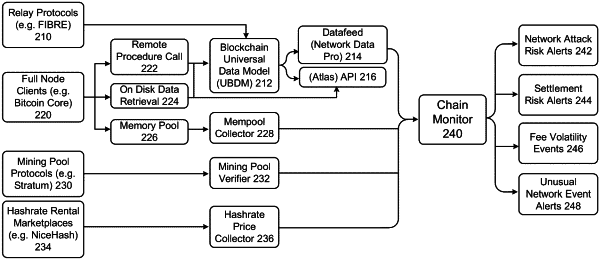| CPC G06Q 20/389 (2013.01) [G06F 16/2379 (2019.01); G06F 21/554 (2013.01); G06Q 20/4016 (2013.01); G06F 2221/034 (2013.01); G06Q 2220/00 (2013.01)] | 22 Claims |

|
12. A method for implementing blockchain network risk management, the method comprising the steps of:
receiving, via a data interface, transaction data from a plurality of data sources, wherein the data interface communicates with the plurality of data sources through a communication network via an application programming interface, the plurality of data sources comprising relay protocols, client nodes, mining pool protocols and hashrate rental marketplaces, the data interface further comprising a data feed interface;
accessing, via a mempool querying engine, data relating to unprocessed transactions stored in a memory pool;
accessing, via a mining pool verifier, block hash data from a plurality of mining pools;
accessing, via a hashrate price collector, rates data from one or more hashrate rental marketplaces relating to mining supply and demand information;
based at least in part on the block hash data from the plurality of mining pools and the rates data from the one or more hashrate rental marketplaces, generating, by a network processor, a network attack risk that represents a risk of network disruption;
based at least in part on the transaction data, generating, by a settlement processor, a settlement risk that includes one or more dynamic thresholds that reflect one or more events being experienced by a network that could prevent settlement;
based at least in part on data relating to the unprocessed transactions stored in the memory pool, generating, by a fee processor, a fee volatility risk that identifies an abnormal change in one or more of: mempool transaction fees and mempool transaction count;
based at least in part on the transaction data, generating, by an event processor, a network event alert that represents unexpected inflation in real-time; and
generating, via an interactive user interface, at least one alert that represents an indication of risk comprising a combination of the network attack risk, the settlement risk, the fee volatility risk and an unusual network event risk.
|